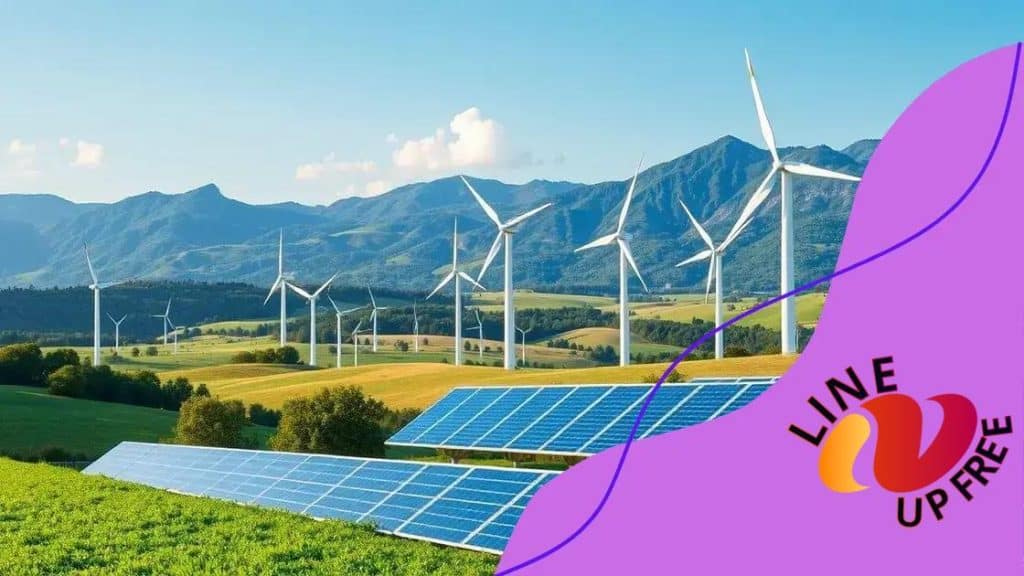Green finance: The next frontier for socially responsible investing

Anúncios
Green finance represents financial investments aimed at supporting sustainable projects that produce positive environmental and social impacts, driving significant changes in the investment landscape.
Green finance: The next frontier for socially responsible investing is not just a trend; it’s reshaping how we think about capital and its impact on our world. Ever wondered how your investments can contribute to sustainability? This article dives into the transformative power of green finance.
Anúncios
Understanding green finance initiatives
Understanding green finance initiatives is essential in today’s world. These initiatives are designed to support sustainable projects and reduce environmental impact. Green finance aims to mobilize funds for projects that benefit the environment, creating a positive impact for both investors and society.
Key Components of Green Finance
Green finance comprises several components that encourage investments in sustainability. These include:
- Green bonds: Financial instruments used to fund projects with environmental benefits.
- Sustainable investment funds: Portfolios that focus on companies promoting eco-friendly practices.
- Environmental risk assessments: Evaluating potential environmental impacts before financing a project.
Moreover, the rise of green finance is changing the investment landscape. Companies are starting to embrace sustainability to meet consumer demand and regulatory requirements. Investors are increasingly looking for ways to support initiatives that align with their values.
Anúncios
The Role of Financial Institutions
Financial institutions play a crucial role in promoting green finance initiatives. Banks and investors are shifting their strategies to incorporate sustainability into their decision-making processes. By offering green loans and funds, they attract eco-conscious investors who want to make a difference.
The commitment to green finance is becoming more visible. Organizations are collaborating to create frameworks that support eligible projects. These frameworks ensure transparency and accountability, making it easier for investors to participate in green finance.
As the demand for sustainable projects grows, education about green finance initiatives becomes vital. Both investors and businesses can benefit from knowing how to navigate this evolving landscape. By understanding these initiatives, they can make smarter choices that contribute to a better future.
The role of government in promoting green investments
The role of government in promoting green investments is essential for creating a sustainable economy. Governments can influence financial markets through policies and regulations that support environmentally friendly projects. By setting clear guidelines, they encourage investors to consider green options.
Policy Frameworks
Effective policy frameworks are crucial for increasing investments in sustainability. Policies that promote renewable energy and energy efficiency provide financial incentives for private companies. Governments can implement tax breaks, subsidies, and grants to stimulate growth in green sectors.
- Investment tax credits: Incentives that reduce taxes for companies investing in renewable energy projects.
- Subsidies for green technologies: Financial support for developing and implementing eco-friendly technologies.
- Regulatory measures: Laws that require companies to meet certain environmental standards.
Governments also play a key role in raising awareness about the importance of green investments. By showcasing successful projects and offering educational resources, they can inspire businesses and individuals to take part in sustainable initiatives.
Public-Private Partnerships
Another vital aspect of government involvement is fostering public-private partnerships. These collaborations can leverage the strengths of both sectors to promote green investments effectively. Through these partnerships, governments can share the financial risks associated with new projects.
The impact of these initiatives can be profound. When the government supports sustainable projects, they create a ripple effect throughout the economy. As more companies engage in green practices, the overall demand for sustainable products increases. This trend not only benefits the environment but also fosters economic growth.
In summary, the involvement of government in promoting green investments is essential for building a sustainable future. Their policies, funding initiatives, and collaborative efforts with private sectors lead to real change in our approach to investment and environmental stewardship.
Key sectors benefiting from green finance

Key sectors benefiting from green finance are crucial for understanding how investments can positively impact our environment. By directing funds towards sustainable initiatives, various industries can thrive while addressing environmental challenges.
Renewable Energy
The renewable energy sector is one of the biggest beneficiaries of green finance. Investments in solar, wind, and hydroelectric power are crucial for reducing our reliance on fossil fuels. These projects not only create jobs but also help decrease greenhouse gas emissions.
- Solar power: Solar panels harness sunlight to generate electricity, making it a clean energy source.
- Wind energy: Wind turbines capture wind energy, providing a sustainable and abundant energy supply.
- Hydropower: Utilizing the flow of water, hydropower offers a reliable energy source with low emissions.
These renewable projects flourish with the right financial support, driving innovation and development in energy technology.
Transportation
The transportation sector is also transforming due to green finance. Funding for electric vehicles (EVs) and public transit systems can significantly cut pollution levels. Electric buses and trains are setting new standards for sustainable transit, reducing reliance on gasoline and diesel.
As countries invest in infrastructure for EVs, the transition to cleaner transportation methods accelerates. This sector’s growth is also supported by financial incentives for consumers choosing electric over traditional vehicles.
Waste Management
Investments in sustainable waste management are essential for promoting circular economies. Green finance supports technologies that recycle materials and reduce landfill waste. Innovative waste-to-energy projects are emerging, turning waste into valuable energy resources. Recycling programs play a vital role by conserving resources and lowering environmental impacts.
By focusing on these key sectors, green finance not only fosters economic growth but also emphasizes the importance of sustainable practices. As more industries adapt to eco-friendly methods, the overall impact on our planet improves significantly.
Challenges faced in green investment strategies
Challenges faced in green investment strategies can hinder the progress of sustainability initiatives. Understanding these challenges is crucial for investors aiming to support environmentally friendly projects. Despite the growth in interest, several obstacles remain in the pathway to effective green finance.
Market Uncertainty
One significant challenge is market uncertainty. Investors often fear that changing regulations and policies could affect their investments. Fluctuations in government support for green projects can lead to hesitancy among potential investors. This uncertainty can also stall long-term projects that need stable funding over time.
High Initial Costs
Another roadblock is the high initial costs associated with many green investments. Renewable energy projects may require considerable upfront capital. For instance, installing solar panels or building wind farms often entails substantial expenditures, which can be a barrier for some investors. However, these costs can be mitigated over time through savings on utility bills and government incentives.
- Funding availability: Limited access to capital can restrict green projects from getting off the ground.
- Return on investment (ROI): Some investors worry about the long payback periods commonly associated with green technologies.
- Technological advancements: Rapid changes in technology can render investments obsolete quickly.
In addition, the lack of standardized metrics for measuring the impact of green investments makes it difficult for investors to compare projects. Without clear benchmarks, it’s challenging to evaluate risks and rewards properly. This lack of transparency can deter investment in sectors that could be incredibly beneficial to the environment. Additionally, investors might find it challenging to assess the long-term viability of green projects, particularly in emerging markets.
While these challenges can seem daunting, ongoing efforts to improve regulations and make green finance more accessible can help overcome them. As more investors recognize the importance of sustainability, the drive to tackle these obstacles will likely strengthen. Working collaboratively, stakeholders in the green financing ecosystem can navigate these challenges effectively.
Future trends in socially responsible investing
Future trends in socially responsible investing are shaping the way investors approach their portfolios. As awareness of environmental and social issues grows, investors are increasingly seeking opportunities that align with their values. This shift reflects a broader desire to make investments that have a positive impact on society and the environment.
Increased Demand for Transparency
One key trend is the increased demand for transparency in investment practices. Investors want to understand how their money is being used and the impact it has on social and environmental issues. Companies that provide clear and detailed information about their sustainability practices are more likely to attract investments.
Emerging Technologies
Emerging technologies play a significant role in the future of socially responsible investing. Innovations like blockchain can enhance transparency and traceability in supply chains. These technologies make it easier for investors to monitor and assess the sustainability of their investments.
- Green fintech: Financial technology focused on sustainable investments is helping to streamline processes and connect investors with green projects.
- Data analytics: Advanced data tools are enabling investors to make informed decisions based on environmental, social, and governance (ESG) criteria.
- Artificial Intelligence: AI is being used to analyze trends and predict the long-term impacts of various investments on sustainability.
Furthermore, younger generations are driving a cultural shift towards investments that prioritize ethical considerations. As millennials and Gen Z begin to take on more investment roles, their preference for companies that demonstrate a commitment to sustainability will push the market in new directions.
Integration of ESG Metrics
Another emerging trend is the integration of ESG metrics into traditional financial analysis. Investors are increasingly looking at how environmental, social, and governance factors affect a company’s bottom line. This approach helps to identify risks and opportunities that may not be apparent through conventional financial metrics alone.
As the market for socially responsible investing continues to grow, we can expect greater collaboration among investors, companies, and regulators. This collaboration will help redefine success in investing, emphasizing not just financial returns but also the positive impact on society and the environment.
socially responsible investing is bright and filled with opportunities. As awareness grows, investors are seeking to align their portfolios with their values, driving positive change. Key trends include increased demand for transparency, the integration of technology like blockchain, and a shift toward measuring environmental, social, and governance (ESG) impacts. These changes are reshaping the investment landscape and highlighting the importance of sustainability. Collaboration among investors, companies, and regulators will continue to enhance the effectiveness of these strategies, ensuring that both people and the planet benefit from the investments made today.
FAQ – Frequently Asked Questions about Green Finance and Socially Responsible Investing
What is green finance?
Green finance refers to financial investments that aim to support sustainable projects and initiatives that have positive environmental impacts.
How can I start investing in socially responsible companies?
You can start by researching funds or companies that align with your values regarding social and environmental responsibility and considering investments in such areas.
What are ESG metrics?
ESG metrics refer to Environmental, Social, and Governance criteria used to evaluate a company’s practices and performance in sustainability.
Why is transparency important in socially responsible investing?
Transparency helps investors understand how their money is being used and the impact of their investments, fostering trust and accountability.





